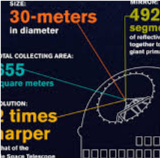Fact Box: India's Contribution to Thirty Metre Telescope (TMT) Project
Thirty Metre Telescope (TMT) is the world’s biggest telescope which would facilitate astronomers to observe the intricacies of the universe from earth.
Salient Facts
Thirty Metre Telescope (TMT) is a multi- million dollar project being developed by an international consortium of Five countries including India. The other four countries are Canada, China, Japan and the U.S. In July 2013, five countries participating in the project had inked Master Partnership Agreement (MPA) for the construction of the Thirty Meter Telescope (TMT).
The ambitious next-generation telescope would be built at a cost of USD 1.47 billion. India will spend Rs 1,300 crore on the project. India’s contribution to the project will be more in terms of hardware than money.
The telescope which was expected to be started at Mauna Kea, Hawaii was stalled following protests by locals. The project site is still being finalised by the consortium of countries involved in the project. Hanle in Ladakh is one among the new sites that are being explored for the construction of the telescope.
The telescope is expected to be ready by 2020. The telescope when ready would offer astronomers with unparalleled power to observe the universe.
India has a 10% partner in the telescope project. Indian astronomers will get observational time in proportion to India’s share in the total project cost.
On the Indian side, the project will be handled by the Ministry of Science and Technology and the Department of Atomic Energy. The project would be led by the Indian Institute of Astrophysics (IIA), Bangalore, with the help of the Aryabhatta Research Institute of Observational Sciences (ARIES), Nainital, and Inter-University Centre for Astronomy and Astrophysics (IUCAA), Pune.
TMT will be the first ground-based telescope to incorporate the technology of Adaptive Optics (AO) as an integral component of the telescope. India’s contributions will include fabrication of edge sensors, which sense relative displacement of segments due to gravity and temperature while tracking objects in the sky. India also has the responsibility to build the entire actuator system to provide the best possible image of objects in the sky.
Month: Current Affairs - June, 2017


